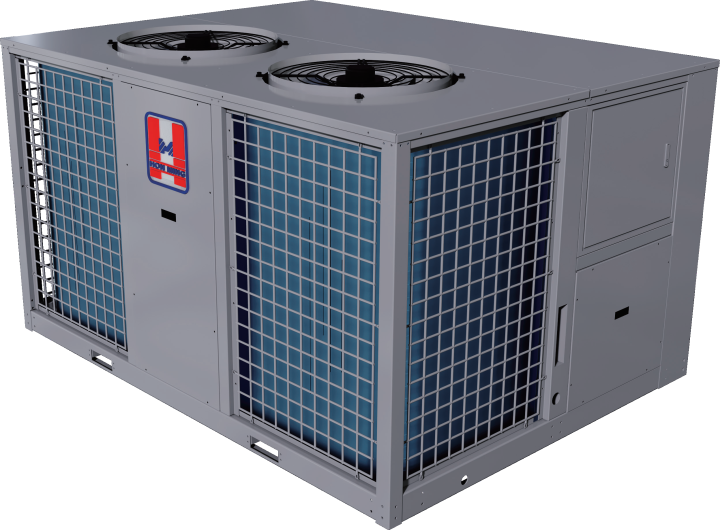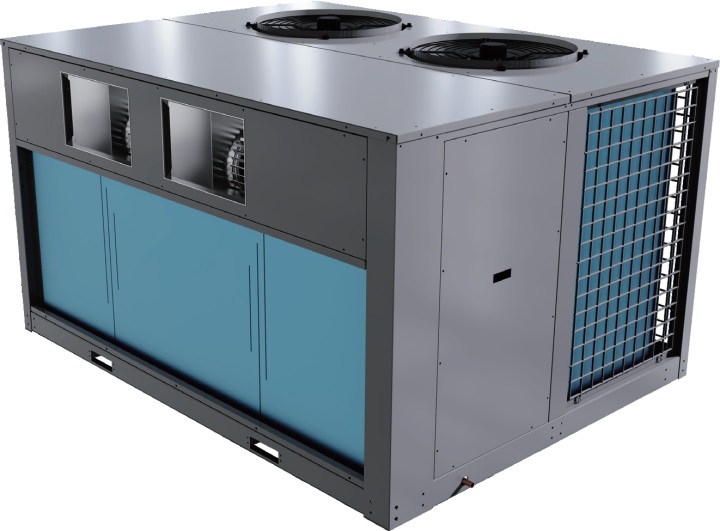What Is a Rooftop Air-Cooled Air Conditioning (Heat Pump) Unit ?
The rooftop air-cooled air conditioning (heat pump) unit is a large to medium-sized HVAC system that integrates cooling, heating, and air purification functions. The system houses the compressor, evaporator, condenser, and expansion components within a single enclosure, making it a self-contained unit. Since these units are typically installed on rooftops, they are commonly referred to as “rooftop air conditioning units” (or simply “rooftop units”).

Key Advantages:
- High Efficiency & Energy Saving – Optimized for performance with lower energy consumption.
- Low Installation Cost – Compact design eliminates the need for extensive piping and separate components.
- Convenience & Ease of Use – Simple operation and minimal maintenance requirements.
- Stable Performance – Reliable system operation across various environmental conditions.
- Low Maintenance Costs – Fewer components and a centralized structure reduce servicing expenses.
Product Features
🔹 Safe & Reliable
The unit is rainproof, insulated, and well-sealed to ensure electrical safety. Power wiring is housed within the electrical control box, preventing roof leaks. The unit is equipped with high-pressure, low-pressure, overload, phase loss, phase reversal, and overheating protection to ensure safe and reliable operation.
🔹 Compact Structure
The unit features a rational layout, integrating the evaporator air supply section and compressor-condensing section into a single assembly. Its unique structural design seamlessly combines the refrigeration and ventilation systems.
🔹 Easy Maintenance
The unit’s highly integrated internal design makes operation and maintenance simple. Faults can be easily diagnosed, and component replacement is convenient within the available space.
🔹 Efficient & Quiet
Utilizing direct expansion (DX) evaporative cooling, the system eliminates the need for secondary heat exchange, improving efficiency. It ensures precise real-time energy control to match air conditioning load requirements, optimizing performance, reducing operating costs, and enhancing cooling effectiveness. The unit is placed outdoors, requiring only air ducts indoors, which minimizes indoor noise and saves space.
🔹 Superior Dehumidification
The direct expansion evaporative cooling system includes both sensible and latent heat dehumidification functions, making it ideal for low-temperature, high-humidity environments. This ensures stable indoor temperature control, particularly in rainy or high-humidity seasons.

Selection of Internationally Renowned Brand Compressors
The compressor consists of two scroll plates—one fixed and one orbiting—offset by 180°, engaging with each other in a dual-function equation-type profile. The orbiting scroll is driven by a crankshaft with a minimal eccentricity and is constrained by an anti-rotation mechanism, allowing it to move in a small-radius planar motion around the fixed scroll. This movement forms a series of crescent-shaped working chambers that gradually compress the refrigerant.
Key features and advantages:
- Minimal pressure difference between adjacent compression chambers reduces gas leakage.
- The continuous suction, compression, and discharge process results in a slow pressure rise, leading to low torque fluctuations and minimal vibrations.
- No suction or discharge valves, ensuring high efficiency, high reliability, and low noise.
- Strong resistance to impurities and liquid slugging—if internal pressure becomes excessively high, the orbiting scroll disengages from the fixed scroll, instantly relieving pressure.
- The compressor housing serves as a discharge chamber, minimizing suction gas preheating and enhancing volumetric efficiency.
- The centripetal gas flow enables liquid injection cooling and intermediate gas injection, facilitating economizer operation for improved performance.
Applications:
Rooftop air-cooled air conditioning (heat pump) units are widely used in rail transit systems, industrial facilities, and other large commercial or industrial environments requiring efficient climate control.
